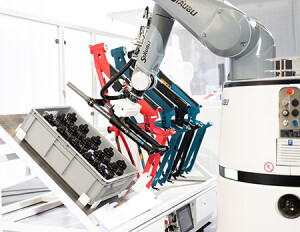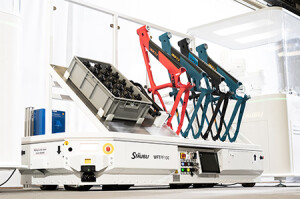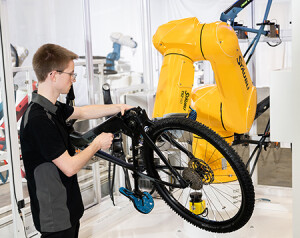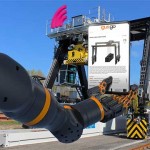A vision of the future or reality today?
 Ever since robots started to become a mainstream part of manufacturing, the concept of fully automated flexible production has been the ultimate objective for businesses across a wide range of sectors. Moving towards this goal has been an iterative process with ongoing developments in hardware, software and connectivity making it possible to continually enhance the flexibility and capability of automated manufacturing.
Ever since robots started to become a mainstream part of manufacturing, the concept of fully automated flexible production has been the ultimate objective for businesses across a wide range of sectors. Moving towards this goal has been an iterative process with ongoing developments in hardware, software and connectivity making it possible to continually enhance the flexibility and capability of automated manufacturing.
With the notable exception of the automotive sector, many early robot installations generally operated as stand-alone systems, performing repetitive tasks on the same parts with little or no links to any other part of the manufacturing process. Now, as Industry 4.0 firmly establishes itself as the template for a more automated future, factories are increasingly digitising their processes and as a result all aspects of the business from manufacturing to warehousing, distribution, and sales, are becoming networked and able to communicate in real time.
 This allows robots and many other manufacturing technologies to operate with much greater degrees of flexibility, connectivity and autonomy making it possible to consider automating manufacturing and assembly processes from beginning to end.
This allows robots and many other manufacturing technologies to operate with much greater degrees of flexibility, connectivity and autonomy making it possible to consider automating manufacturing and assembly processes from beginning to end.
The capability of today’s technology to achieve end to end automated manufacturing was clearly demonstrated by Stäubli during their recent Robotics Innovation Days. Here the company’s four product families – industrial robots, collaborative robots, mobile robots and Automated Guided Vehicles (AGVs) operated together to perform final assembly operations on an E-Bike.
 Stäubli’s Simon Jenkins explains: “Although shown as part of our Innovation days, the E-Bike assembly operations are a perfect example of what can actually be achieved today. We have available a powerful and comprehensive range of 6 axis and SCARA robots, AGV and autonomous fork-lift technologies which can deliver parts to the line from the warehouse, load them to the appropriate workstations, perform the various assembly tasks, either fully automatically or in collaboration with humans and return finished components to dispatch if required.”
Stäubli’s Simon Jenkins explains: “Although shown as part of our Innovation days, the E-Bike assembly operations are a perfect example of what can actually be achieved today. We have available a powerful and comprehensive range of 6 axis and SCARA robots, AGV and autonomous fork-lift technologies which can deliver parts to the line from the warehouse, load them to the appropriate workstations, perform the various assembly tasks, either fully automatically or in collaboration with humans and return finished components to dispatch if required.”
The agile approach to manufacturing which can be achieved through Industry 4.0 connectivity also makes it possible to fulfil the growing trend across a number of sectors for customised or personalised products. This requires processes and technologies to respond dynamically to produce individual items to customer specifications. Robots play a key role in achieving these objectives through their ability to communicate with each other and quickly adapt to changing production requirements whilst maintaining the highest levels of quality and productivity.
Jenkins concludes: “What was once thought of as the ‘factory of the future’ has become the factory of today, and the new factory of the future will capitalise on the ever increasing capabilities of robots in all of their forms. Mobile robots and continued growth in areas of human-robot collaboration, together with ever more capable industrial robots, will be at the heart of the next generation production lines.”
Visit the Stäubli Robotics website for more information
See all stories for Stäubli Robotics















